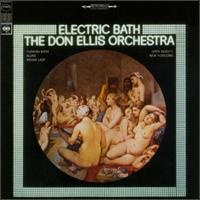Electric Bath
Date(s) Recorded
September 17, 1967 – September 20, 1967
Tracks
Indian Lady (Ellis) – 8:07
Alone (Levy) – 5:32
Turkish Bath (Myers) – 10:29
Open Beauty (Ellis) – 8:27
New Horizons (Ellis) – 12:21
Turkish Bath – single (Myers) – 2:52*
Indian Lady – single (Ellis) – 2:58*
* Included on CD Reissue, not original LP release
Credits
Don Ellis – Trumpet
Ruben Leon – Alto Sax, Soprano Sax, Flute
Joe Roccisano – Alto Sax, Soprano Sax, Flute
Ira Shulman – Tenor Sax, Piccolo, Flute, Clarinet
Ron Starr – Tenor Sax, Flute, Clarinet
John Magruder – Baritone Sax, Flute, Clarinet, Bass Clarinet
Steve Bohannon – Drums
Frank DeLaRosa – Bass
Alan Estes – Percussion, Timbales, Vibraphone
Bob Harmon – Trumpet
Michael Lang – Piano, Keyboards, Clavinet
Ron Myers – Trombone
Tom Myers – Trombone
Ray Neapolitan – Bass, Sitar
Dave Parlato – Bass
Mark Stevens – Percussion, Timbales, Vibraphone
Glenn Stuart – Trumpet
Chino Valdes – Bongos, Conga
Edward Warren – Trumpet
Alan Weight – Trumpet
Alan Wight – Trumpet
Terry Woodson – Trombone
Mike Lang – Piano, Clavinet
David Sanchez – Trombone
Liner Notes
Digby Diehl
Releases
Columbia/Legacy 9585 (1967)
GNP Crescendo 2223 (1994) – CD Reissue
Columbia/Legacy 65522 (1998) – CD Reissue (remastered): Available at CDNOW for $10.49
Notes
Packaging includes a short quote from Henry Mancini.
Electric Bath (1967), which was nominated for a Grammy award and also earned an “Album of the Year” award from Down Beat magazine, quickly became Ellis’s most popular release to date. The recording was Ellis’s first studio album with his orchestra and also his first on the Columbia label. The 5/4 “Indian Lady,” from the Electric Bath session, features passages of Indian-inspired textures and became a fan favorite. A shortened version was released as a single. Another selection on the recording, titled “Open Beauty,” features psychedelic webs of electronic effects, including creative trumpet improvisation by Ellis utilizing an echoplex tape-loop.
The studio environment of Electric Bath provided Ellis the ability to control every aspect of the recording. This control resulted in a more sophisticated production and tighter performances than that of his first two live recordings. Regarding Electric Bath, Henry Mancini commented, “My rock-oriented teenage son, Chris, and I have both flipped out over Don Ellis’s new band. Anyone who can reach these two opposite poles at once must be reckoned with and listened to.”
Of the same recording, noted jazz critic, Digby Diehl,
commented in the liner notes:
“Conceive, if you can, an aural collage created by the Beatles, Karlheinz Stockhausen, Ravi Shankar and Leonard Feather’s Encyclopedia of Jazz. And then, imagine that creation churning through the high-powered talents of twenty-one young musicians, like a rumble before you open the door of a blast furnace. Electric Bath runs this scope of ideas and intensity [ . . . ] Don’s use of a funky 7/4 or a blues in 5 gives us a delightfully renewed sense of tension in rhythm. New tempos change our awareness of accents, break down the cliché phrases based on 2/4 or 4/4, and [ . . . ] make us listen in very real natural extensions of a modern musical conception. The Don Ellis Band has no academic hang-ups about its music – it just radiates good vibrations in a refreshing contemporary idiom.”


